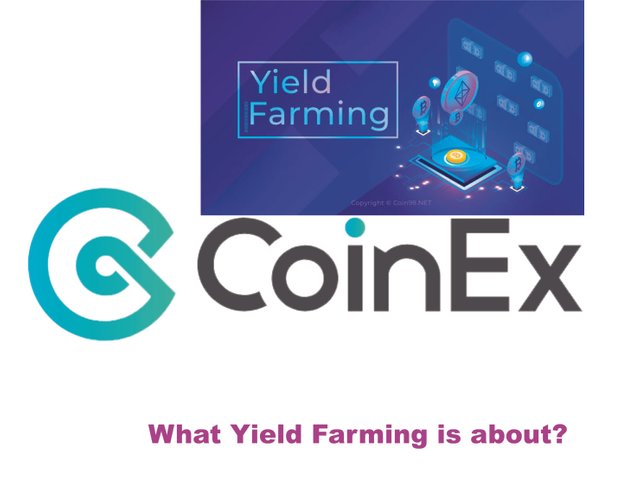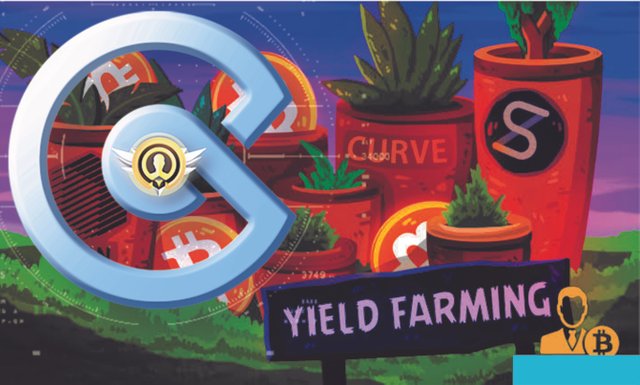Yield Farming

Yield Farming is the most currently discussed topic in all the Decentralized Finance (Defi) ecosystem. In case you missed my article about what Defi is all about, please read it here.
WHAT YIELD FARMING IS ALL ABOUT?
Yield Farming is simply a way of maximising the rate of return on your capital by leveraging different DeFi protocols. In short, it is a way of making more crypto with your crypto. Yield Farming involves you lending out your funds to borrowers through smart contracts and gets the return in form of crypto.
Yield Farming is a new concept of earning rewards for holding your cryptocurrency using permissionless liquidity protocols. Yield Farming enables us to earn passive income using the Defi product built on Ethereum.
Yield farming could also be term as liquidity mining. In another definition, Yield Farming simply means for you to hold or lock your cryptocurrency while generating rewards for your services. Yield Farming could be seen as staking, but there a lot of differences between it works with liquidity providers that add funds to liquidity pools.
Yield Farming activities are currently done on ethereum ecosystem i.e it is done using Erc-20 tokens on Ethereum, and the return is also an Erc-20 tokens
Here is a question you should ask yourself...
Why will you keep your asset idle whereas you can put them to work to get you a return through Yield Farming.
HOW DOES YIELD FARMING WORKS
There are two things that involves when we talk about Yield Farming
- Liquidity Providers (LPs)
- Liquidity pools
The Liquidity Providers are the people that fund the liquidity pool i.e those that deposited into the Liquidity pools, whereas the Liquidity pools itself facilitate a marketplace where people can borrow, lend, and exchange their tokens.
The Liquidity Providers get a share from the fees Liquidity pools incurs on the users. Note that using the liquidity pool is not free, there are fees you paid and that is where the Liquidity Providers get their own share. This is another medium of earning passively in the crypto industry.
However, the amount of share a Liquidity Provider could earn is not certain, rather it depends on the rules and features of the protocol. Moreover, the only certain thing here is that the more funds you deposit into the Liquidity pools, the more incentives you earn. Commonly, most of the funds Liquidity Providers can deposit are stablecoins pegged to the USD i.e USDT, DAI, USDC and other common stablecoin. Again! Some of the Yield Farming protocol mint a token that represents the one you deposited while some mint a third-party tokens. So it is good to first go through the terms of each protocol before funding the Liquidity pools.

HOW TO CALCULATE YIELD FARMING RETURN
The calculation of Yield Farming is estimated annually. There are two notable parameters used for the calculation.
- Annual Percentage Rate (APR)
- Annual Percentage Yield (APY)
Annual Percentage Rate (APR) is used for calculating the annual return of the Yield Farming without considering the effects of compounding (direct reinvestment of your return), while Annual Percentage Yield (APY) is used for calculating the annual return of the Yield Farming by considering the effects of compounding.
I would like you to have it at back of your mind that all these calculations are merely based on estimation and it will be difficult to get accurate calculation of the return. You might wonder why the calculation of the return could not be accurate, however the answer is because Yield Farming is highly competitive, Yield Farmers can jump from one protocol to another and the rewards can easily fluctuate rapidly.
Looking to get started with cryptocurrency? Buy Defi tokens on CoinEx!
For us to understand this topic very well, I will like to define and explain some terminologies.
YIELD FARMER
Someone that lends out his fund is called Yield Farmer while the process of lending it out to earn more is what we termed "Yield Farming". The Yield farmers can gain higher yield by changing between multiple and different strategies i.e the Yield Farmers are found to move their funds around between different protocols in search of potential high yields.
The best way to get profitable strategies is for you as a Yield Farmer getting involved in multiple DeFi protocols such as Synthetic,Curve, Balancer, Compound etc.
What these platforms do in order to attract more capital into their platform is by offering different economic incentives.
CROP ROTATION
There is another term used in the Defi ecosystem. It is a process of a Yield Farmer shifting from his previous strategy to a new strategy i.e moving his fund from the previous strategy to another strategy that has a better annual yield percentage. The process will require him to swap his coin to the new project coin.
COLLATERALIZATION IN DEFI
You know in traditional finance institutions like banks always request their customers to bring collateral before they could offer them a loan. Same thing is applicable in the Defi ecosystem but totally in a different dimension.
So borrowing assets through the Yield Farming requires you to put up collateral that will cover up your loan and acts as insurance for your loan. This process is what we called "collateralization in DeFi".
Though the collateral you could put for your loan depends on the protocol you are offering your funds. It is therefore compulsory to always check the collateralization ratio so that you will know the best to choose, because if your collateral’s value goes down beyond what the protocol requires, there is a tendency for your collateral to be liquidated. So the only measures to avoid your collateral being liquidated is for you to add more collateral.
In short, most of the Defi protocols do have a certain required collateralization ratio. Meanwhile, most of the protocols only allow borrowers to deposit a certain asset that is greater than what they want to borrow. All these measures are necessary because it helps in reducing the risk of market violation that might crash liquidating a huge amount of collateral in the system.
TOTAL VALUE LOCKED (TVL)
Total Value Locked (TVL) is the overall measure used in weighing the total number of the DeFi yield farming that has been locked. Simply put, Total Value Locked (TVL) is used to know how much crypto that has been locked in DeFi lending and other related marketplaces.
Total Value Locked (TVL) is the accumulated liquidity in liquidity pools. It is used in knowing the market share of Defi protocol and generally used in knowing the health of the yield farming market and Defi at large. Currently, the Total Value Locked (TVL) can be tracked from a platform called Defi Pulse.
ADVANTAGES OF DEFI OVER TRADITIONAL FINANCE
Defi has a lot of advantages over traditional finance. In the Defi system, you can find the best saving account with the highest annual percentage yield (APY). If the Yield Farmers discover the strategy they are using is no longer working nor profitable, they can switch around to other better available strategies with the highest annual percentage yield. The Yield Farmers have the privilege to move their funds around, switch around different protocols and swap from one coin to another with a better annual percentage yield.
In the traditional finance system, the common annual percentage yield for most savings accounts is between 0.1% to 3% APY. With my knowledge so far, it is usually not above 3%. However, the case is entirely different in Yield Farming and it is far better than the traditional finance system. There are some of the Yield Farming that has an 100% annual yield percentage. This is really massive and far better. So if you are still saving your money in the banks in order to be earning 1% to 3% of annual percentage yield, you are on big jokes. Kindly migrate to Defi ecosystem and become a Yield Farmer.
.jpeg)
PLATFORMS THAT SUPPORTS YIELD FARMING INNOVATION
Compound Finance (COMP)
Compound is a Defi project and one of the core protocols of Yield Farming that allows users to lend and borrow assets. The platform allows people with an Ethereum wallet to deposit assets into the Compound’s liquidity pool while earning rewards for his services. The rate of return is calculated based on the demand and supply.
Looking for where to trade COMP tokens? Check CoinEx!
Buy COMP directly here
Balancer (BAL)
The Balancer protocol is an exciting innovation for Yield Farming. Balancer is a decentralized exchange protocol that enables trustless token swaps which is somehow related to Uniswap but there are differences in the sense that the Balancer protocol enables users to deposit custom tokens into the liquidity pool while the liquid providers earn fees from the trade that take place on their liquidity pool.
Looking for where to trade BAL tokens? Check CoinEx!
Buy BAL directly here
Synthetix (SNX)
Synthetix is another protocol of Yield Farming, it has something they called "synthetic asset protocol". This protocol allows people to lock up SNX tokens or ETH as collateral while they will mint synthetic assets. Synthetix protocol allows assets with a reliable price to be used for Yield Farming.
Looking for where to trade SNX tokens? Check CoinEx!
Buy SNX directly here
Aave (LEND)
Aave is a decentralized protocol that enables people to lend and borrow assets. This platform is well used for Yield Farming. In Aave protocol, the lenders do "aToken" in return while their interest rates are calculated algorithmically in corresponding to the current market conditions.
Looking for where to trade LEND tokens? Check CoinEx!
Buy SNX directly here
Uniswap (UNI)
Uniswap is another decentralized exchange protocol that enables untrustworthy token swaps. The Uniswap protocol enables users to provide liquidity by depositing an equivalent value of two tokens to create a market where they could trade against that liquidity pool. Meanwhile, the liquidity providers do earn from the fees charges that occur in their pool. The Uniswap protocol is a big tool for Yield Farming.
Looking for where to trade UNI tokens? Check CoinEx!
Buy UNI directly here
There are still many of them, you can do more research on it.
CLOSING THOUGHT!
Yield farming is the engine room of Decentralized Finance (DeFi). Without the Yield Farming, the Defi system won't be much interesting like the way it is now. The Yield Farming enables the Yield Farmers to get a chance to farm the best crops. Yield Farmers have the privilege to use complicated strategies and move their crypto assets around between different lending marketplaces in order to maximize their yield returns. Though the Yield Farmers do keep the best yield farming strategy secretive because once it is flooded, the strategy becomes less effective, but the good thing is that once a strategy has a low return, you can migrate to another protocol with a better annual percentage yield.
Lastly, the major protocol that has higher
profitable yield farming strategies are highly complex. So if you are a novice, I won't advise you to go for it, but the advanced users are good to go for it. Yield Farming is highly profitable to those with higher capital; starting a Yield Farming with low capital is not encouraging. Yield Farming is highly complex and if you don't understand it well, there will be tendency for you to lose all your capital. So please study it well and weigh all the risks involved before going into it. There are measures to curb the risk, please do well to know all.